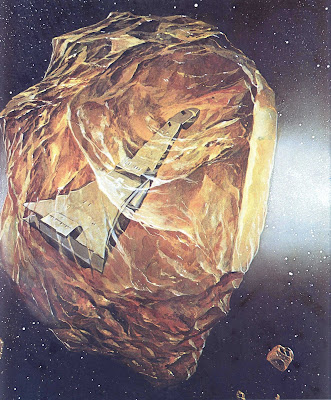In the late 70s Harry Harrison authored several trade
paperback, sf art books : 'Great Balls of Fire' (1977), 'Mechanismo' (1978) and
'Planet Story' (1979). This was something of an adventure in sf publishing, for
at that time, art books with sf or fantasy themes were comparatively rare, and
the chain stores (Waldenbooks, Coles, and B. Dalton) that dominated the retail
sphere in those days were only just beginning to realize that additional shelf
space and inventory should be devoted to the genre.
Mechanismo (120 pp) is printed on quality stock, and at 10 ¼
x 10 ¼ “, couldn’t entirely fit onto the platen of my scanner. So the images I’m
posting here are cropped to some extent.
Angus McKie
Harrison’s contribution are 6 short essays on ‘Star Ships’, ‘Mechanical
Man’, Weapons and Space Gear’, ‘Space Cities’, ‘Fantastic Machines’, and ‘Movies’.
Additional text, apparently supplied by the publisher, provides commentary –
some of it fictional – for the illustrations. Most (all ?) of the artwork in
Mechanismo was previously published, usually as cover art for sf paperbacks
published in the UK.
Colin Hay
Jennifer Eachus
Richard Clifton-Dey
Overall,
Harrison’s essays are entertaining rather than pedantic, and written with a
note of humor. There are some tidbits dropped that may move readers to seek out
70s sf novels and story collections (for example, I’d never been aware of
Harrison’s matter transmission anthology, 'One Step from Earth' (1970), prior to
reading about it in Mechanismo).
Robin Hiddon
Jim Burns
Angus McKie
The quality of pieces (which are reproduced in black and
white and color) from the 19 participating artists varies; some are well done,
while others are mediocre. The works by Jim Burns, a rising star in the sf
illustration field, are among the most eye-catching. There are a large number
of contributions from Angus McKie, the leading sf illustrator in the late 70s
and a frequent contributor to Heavy Metal magazine. Ralph McQuarrie provides
some paintings from Star Wars, and there are a couple of H. R. Giger
submissions, too.
Angus McKie (cover of the March, 1979 issue of Heavy Metal)
‘Mechanismo’ may not draw much enthusiasm from contemporary
sf fans, who are used to the revolutionary changes in sf and fantasy
illustration wrought by the use of computers and illustration software. But
those with a nostalgic bent may want to pick up Mechanismo and take in the
flavor of Old School sf illustration.
Angus McKie
Ralph McQuarrie



























































